
Mercury was a brand of mid-priced automobiles produced by American manufacturer Ford Motor Company between 1938 and 2011 with 1939 being the first model year. It stood as its own line within Ford until 1945, and thereafter formed half of Ford's Lincoln-Mercury Division. Created by Edsel Ford in 1938 to bridge the gap between the Ford and Lincoln model lines, its principal competition was General Motors' Buick and Oldsmobile divisions, and Chrysler Corporation's DeSoto and Chrysler brands.
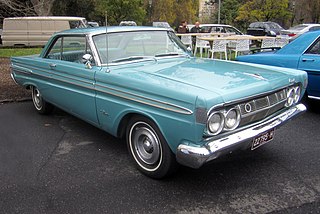
The Mercury Comet is an automobile that was produced by Mercury from 1960–1969 and 1971–1977 — variously as either a compact or an intermediate car. In its first two years, it was marketed as the "Comet" and from 1962 as the "Mercury Comet".
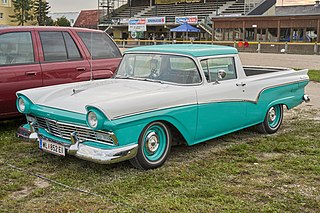
The Ford Ranchero is a coupe utility that was produced by Ford between 1957 and 1979. Unlike a standard pickup truck, the Ranchero was adapted from a two-door station wagon platform that integrated the cab and cargo bed into the body. A total of 508,355 units were produced during the model's production run. Over its lifespan it was variously derived from full-sized, compact, and intermediate automobiles sold by Ford for the North American market.

Personal luxury car is a North American car classification describing somewhat sporty, sophisticated mass-market coupés that emphasized comfort over performance. The North American manufacturers most often combined engineering, design, and marketing to develop upscale, distinctive "platform sharing" models that became highly profitable.

The Ford Country Squire is a series of full-size station wagons that were assembled by American automaker Ford. Positioned as the top-level station wagon of the Ford division, the Country Squire was distinguished by woodgrain bodyside trim. From 1950 through the 1991 model years, eight generations of the Country Squire were produced. Following the discontinuation of Edsel Bermuda, Mercury marketed the Mercury Colony Park as a divisional counterpart of the Country Squire, sharing bodywork and trim while the Mercury was not available with a six cylinder engine and was more expensive due to the optional equipment on the Ford that was standard on the Mercury.
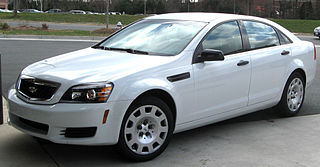
The Chevrolet Caprice is a full-size car produced by Chevrolet in North America for the 1965 to 1996 model years. Full-size Chevrolet sales peaked in 1965 with over a million sold. It was the most popular car in the U.S. in the 1960s and early 1970s, which, during its lifetime, included the Biscayne, Bel Air, and Impala.

The Chevrolet Bel Air is a full-size car produced by Chevrolet for the 1950–1981 model years. Initially, only the two-door hardtops in the Chevrolet model range were designated with the Bel Air name from 1950 to 1952. With the 1953 model year, the Bel Air name was changed from a designation for a unique body shape to a premium level of trim applied across a number of body styles. The Bel Air continued with various other trim level designations, and it had gone from a mid-level trim car to a budget fleet sedan when U.S. production ceased in 1975. Production continued in Canada, for its home market only, through the 1981 model year.

The Mercury Cougar is a series of automobiles that was sold by Mercury from 1967 to 2002. The model line is a diverse series of vehicles; though the Cougar nameplate is most commonly associated with two-door coupes, at various stages in its production, the model also was offered as a convertible and a hatchback. During its production as the mid-size Mercury line, the Cougar was also offered as a four-door sedan and five-door station wagon.

The Ford Fairmont is a model line of compact cars that was manufactured by Ford from the 1978 to 1983 model years. The successor of the Ford Maverick, the Fairmont marked the third generation of compact sedans sold by Ford in North America. Initially slotted between the Pinto and Granada within the Ford line, the Fairmont was later marketed between the Ford Escort and Ford LTD. In contrast to its predecessor, the model line was offered as a two-door notchback sedan, two-door coupe, four-door sedan, and five-door station wagon. Though never sold as a Lincoln, Mercury sold a divisional counterpart of the Fairmont as the Mercury Zephyr.

The Ford Fox platform is an automobile platform that was used by Ford Motor Company. Introduced for compact sedans in the 1978 model year, the Fox architecture was utilized for a wide variety of configurations for Ford and Lincoln-Mercury vehicles. In its original form, the platform was used through the 1993 model year; a substantial redesign of the Ford Mustang extended its life into the 21st century, ending production in 2004. Produced across 26 model years, the Fox platform is the second-longest car architecture ever designed by Ford Motor Company.
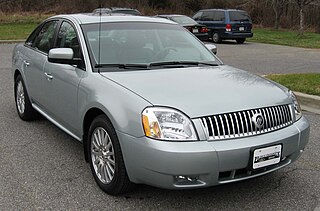
The Mercury Montego is a nameplate that was applied to three separate generations of vehicles marketed by the Mercury division of Ford Motor Company. Taking its name from Montego Bay, Jamaica, the nameplate made its first appearance for 1967 in the Canadian market as part of the Mercury-derived Meteor model line. For 1968, the Mercury Montego made its debut across North America, becoming the Mercury counterpart of the Ford Torino intermediate-size model line for two generations.

The Ford LTD is a range of automobiles manufactured by Ford for the 1965 to 1986 model years. Introduced as the highest trim level of the full-size Ford model range, the LTD moved the Ford range upmarket, offering options and features previously reserved for Mercury and Lincoln vehicles. For much of its production life, the LTD competed against the Chevrolet Caprice ; the Mercury Marquis served as its divisional counterpart from 1967 until 1986.
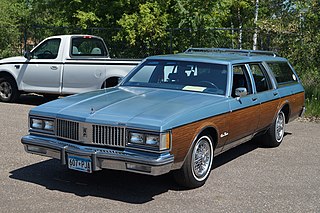
The Oldsmobile Custom Cruiser is an automobile that was manufactured and marketed by Oldsmobile from 1971 until 1992. Marking the return of Oldsmobile to the full-size station wagon segment, the Custom Cruiser was initially slotted above the intermediate Oldsmobile Vista Cruiser, ultimately above the later mid-size Oldsmobile Cutlass Cruiser.
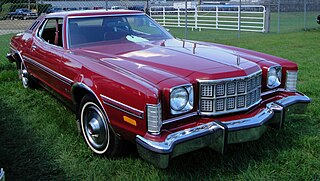
The Ford Elite is a personal luxury car produced by Ford and marketed in North America from February 1974 to 1976, using the name Gran Torino Elite for its first model year only then simplified to just Elite for the following two model years.

The Ford Fairlane is an automobile model that was sold between the 1955 and 1970 model years by Ford in North America. Taking its name from the Dearborn, Michigan estate of Henry Ford, the Fairlane nameplate was used for seven different generations of vehicles. Through its production, the model line would be marketed in a wide variety of body styles, including two-door and four-door sedans, two-door and four-door hardtops, station wagons, and both traditional and retractable-hardtop convertibles.
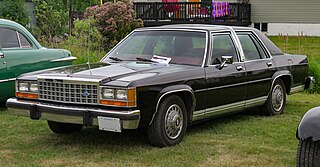
The Ford LTD Crown Victoria is a line of full-size cars that was manufactured and marketed by Ford from the 1980 to 1991 model years. Deriving its name from the Ford Fairlane coupe of 1955–1956, the LTD Crown Victoria served as the flagship of the Ford LTD model range in North America. Serving as the Ford counterpart of the Mercury Grand Marquis, the model line was offered as a two-door and a four-door sedan and a five-door station wagon.

The North American version of the Ford Granada is a range of sedans that was manufactured and marketed by Ford over two generations (1975–1982). Developed as the original successor for the Ford Maverick, the Granada shares its name with Ford of Europe's flagship sedan. The model line was marketed as a luxury compact vehicle, expanding the segment in the United States.
In the context of the automobile industry, downsizing is a practice used to transition vehicles from one size segment to another. Commenced during the Malaise era, downsizing is done in response to consumer and government demands influencing vehicle design. As vehicle product lines completed their model cycles, automobile manufacturers developed the next generation of a vehicle with a smaller exterior footprint to allow for weight reduction and increased fuel economy, using a shortened wheelbase and body length.

The seventh generation of the Ford Thunderbird is a personal luxury car that was built by Ford from the 1977 to the 1979 model years. In a key marketing shift for the model range, Ford repackaged the Thunderbird from a full-size car to an intermediate car, and ceded its full-size luxury coupe status to the Ford LTD Landau coupe. Rather than being the traditional Ford counterpart of the Continental Mark V, the Thunderbird would share the chassis with the Mercury Cougar and the Ford LTD II before the Ford Fox platform version was introduced for 1980.

The eighth generation of the Ford Thunderbird is a personal luxury coupe that was manufactured and marketed by Ford from the 1980 to 1982 model years. Introduced to commemorate the 25th year of the Thunderbird, the eighth generation was substantially downsized, transitioning further into the mid-size segment. For a second generation, the Thunderbird remained the Ford counterpart of the Mercury Cougar XR7; while the Cougar again served as a complete line of mid-sized cars in various body styles starting with 1981 models, the Thunderbird was offered solely as a two-door personal luxury coupe.
























